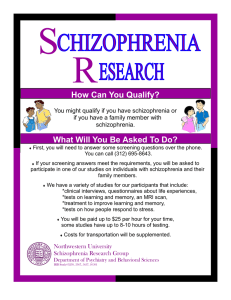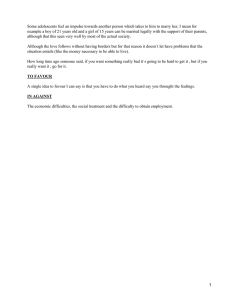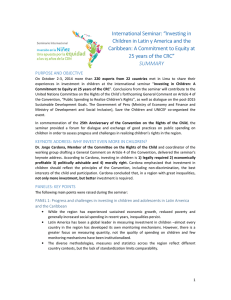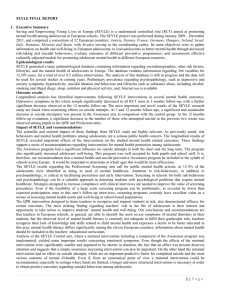Invega : EPAR - Summary for the public
Anuncio
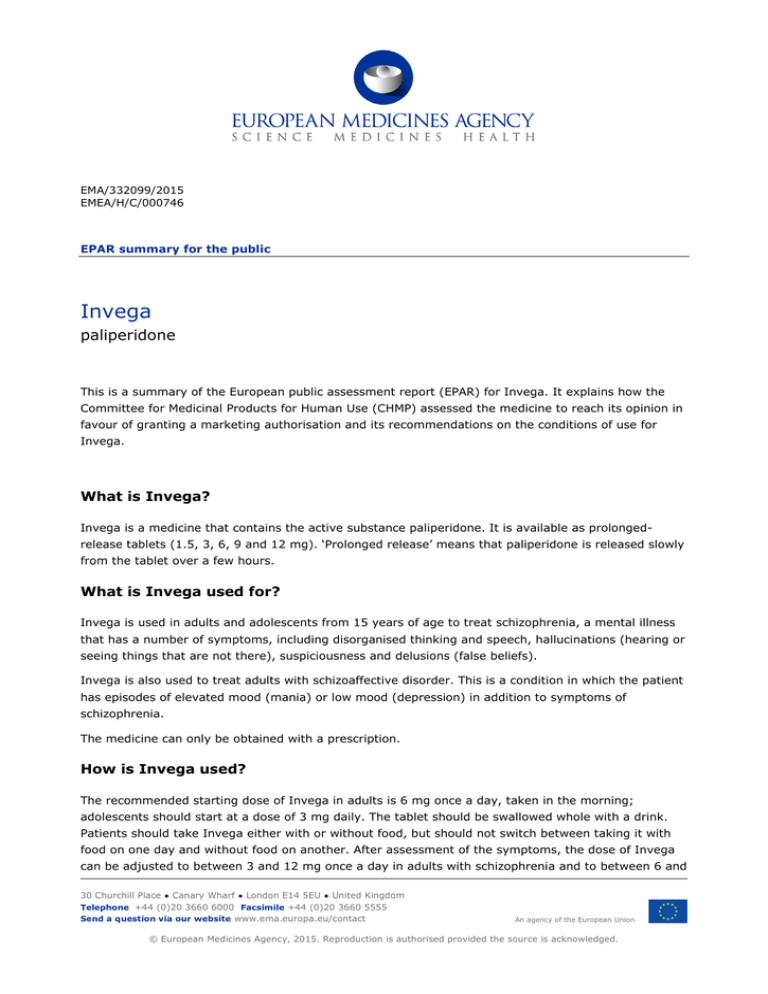
EMA/332099/2015 EMEA/H/C/000746 EPAR summary for the public Invega paliperidone This is a summary of the European public assessment report (EPAR) for Invega. It explains how the Committee for Medicinal Products for Human Use (CHMP) assessed the medicine to reach its opinion in favour of granting a marketing authorisation and its recommendations on the conditions of use for Invega. What is Invega? Invega is a medicine that contains the active substance paliperidone. It is available as prolongedrelease tablets (1.5, 3, 6, 9 and 12 mg). ‘Prolonged release’ means that paliperidone is released slowly from the tablet over a few hours. What is Invega used for? Invega is used in adults and adolescents from 15 years of age to treat schizophrenia, a mental illness that has a number of symptoms, including disorganised thinking and speech, hallucinations (hearing or seeing things that are not there), suspiciousness and delusions (false beliefs). Invega is also used to treat adults with schizoaffective disorder. This is a condition in which the patient has episodes of elevated mood (mania) or low mood (depression) in addition to symptoms of schizophrenia. The medicine can only be obtained with a prescription. How is Invega used? The recommended starting dose of Invega in adults is 6 mg once a day, taken in the morning; adolescents should start at a dose of 3 mg daily. The tablet should be swallowed whole with a drink. Patients should take Invega either with or without food, but should not switch between taking it with food on one day and without food on another. After assessment of the symptoms, the dose of Invega can be adjusted to between 3 and 12 mg once a day in adults with schizophrenia and to between 6 and 30 Churchill Place ● Canary Wharf ● London E14 5EU ● United Kingdom Telephone +44 (0)20 3660 6000 Facsimile +44 (0)20 3660 5555 Send a question via our website www.ema.europa.eu/contact An agency of the European Union © European Medicines Agency, 2015. Reproduction is authorised provided the source is acknowledged. 12 mg once a day in patients with schizoaffective disorder. In adolescents with schizophrenia the maximum daily dose depends on the patient’s body weight and should not be more than 6 mg in those who weigh less than 51 kg. Patients with mild or moderate kidney problems, including some elderly patients, should also start with a lower dose of Invega, but the medicine is not recommended for patients with severe kidney problems. For more information on the use of Invega, including the adjustment of doses, see the summary of product characteristics (also part of the EPAR). How does Invega work? The active substance in Invega, paliperidone, is an antipsychotic medicine. It is known as an ‘atypical’ antipsychotic because it is different from the older antipsychotic medicines that have been available since the 1950s. Paliperidone is an active breakdown product (metabolite) of risperidone, another atypical antipsychotic medicine that has been used in the treatment of schizophrenia since the 1990s. In the brain, paliperidone attaches to several different receptors on the surface of nerve cells. This disrupts signals transmitted between brain cells by ‘neurotransmitters’, chemicals that allow nerve cells to communicate with each other. Paliperidone acts mainly by blocking the receptors for the neurotransmitters dopamine and 5-hydroxytryptamine (also called serotonin), which are involved in schizophrenia. By blocking these receptors, paliperidone helps to normalise the activity of the brain and reduce symptoms. How has Invega been studied? For schizophrenia, Invega has been studied in three main short-term studies involving 1,692 adults, and one short term study involving 200 adolescents aged 12 to 17 years. In all three adult studies, doses of Invega between 3 and 15 mg a day were compared with placebo (a dummy treatment) and with olanzapine (another antipsychotic medicine). In the adolescent study, doses of Invega between 1.5 and 12 mg a day were compared with placebo. The main measure of effectiveness was the change in the patients’ symptoms using a standard scale for schizophrenia after six weeks. An additional study in adults with schizophrenia looked at the long-term effects of Invega in preventing new symptoms for up to 35 weeks in 207 patients who had initially been treated over a 14-week period, and another study involving 228 adolescents looked at the longer-term effects of treatment with Invega over 8 and 26 weeks compared with aripiprazole (another antipsychotic medicine). A supportive study provided information on the use of Invega in adolescents over up to 2 years. Three main studies were carried out in adults with schizoaffective disorder. Two studies assessed the effects of Invega on symptoms of mania whereas the third study assessed the effects on symptoms of depression.. In the first two studies, a total of 614 patients were given either Invega or placebo. The main measure of effectiveness was the change in the patients’ symptoms of mania after six weeks on a standard scale. In the third study, 334 patients received an injectable form of paliperidone for a mood episode for 6 months after which they either received placebo or continued treatment with injectable paliperidone. The main measure of effectiveness was the number of patients whose symptoms of depression came back after treatment. What benefit has Invega shown during the studies? Invega was more effective than placebo and as effective as olanzapine in reducing the symptoms of schizophrenia in adults. In the first short-term study, patients taking placebo had an average fall in their symptom score of 4.1 points, compared with an average fall of between 17.9 and 23.3 points in those taking Invega and of 19.9 in those taking olanzapine. Similar results were seen in the other two short-term studies. Across all three studies, higher doses of Invega were more effective than lower Invega EMA/332099/2015 Page 2/4 doses in reducing symptoms. Comparable results were seen at doses above 3 mg in adolescents, although too few patients aged below 15 years were studied to clearly establish an effect in this younger age group. Invega was also more effective than placebo in preventing the occurrence of new symptoms of schizophrenia in the long-term study in adults, and the overall results of studies were also considered to support longer-term use in adolescents from 15 years of age. In the studies in adults with schizoaffective disorder, Invega was more effective than placebo. In the first study, patients who were given Invega had a fall in their symptom score of between 27.4 and 30.6 compared with 21.7 in patients who were given placebo. In the second study, the fall in symptom score was 20.0 in the Invega group and 10.8 in the placebo group. In the third study, 15% (25 out of 164) of patients given paliperidone had symptoms of depression coming back compared with 34% (57 out of 170 patients) of patients given placebo. What is the risk associated with Invega? The most frequently reported side effects in studies with Invega are headache, insomnia (difficulty sleeping), sleepiness, parkinsonism (neurological symptoms including tremor and impaired muscular control), akathisia (restlessness), tachycardia (increased heart rate), dystonia (involuntary muscle contractions), tremor (shaking), upper respiratory tract infection (colds), anxiety, dizziness, increased weight, nausea, agitation, constipation, vomiting, fatigue (tiredness), depression, dyspepsia (heartburn), diarrhoea, dry mouth, toothache, muscle and bone pain, asthenia (weakness), high blood pressure, back pain, prolonged electrocardiogram QT (an alteration of the electrical activity of the heart) and cough. Side effects in adolescents are similar to those in adults, although some side effects may occur more frequently. For the full list of all side effects reported with Invega, see the package leaflet. Invega must not be taken by people who are hypersensitive (allergic) to paliperidone or any of the other ingredients, or to risperidone. Why has Invega been approved? The CHMP decided that Invega’s benefits are greater than its risks in adults and recommended that it be given marketing authorisation for schizophrenia and schizoaffective disorder. The CHMP noted that for schizoaffective disorder, the medicine has been shown to be effective in treating manic as well as depressive episodes in adult patients. The Committee also considered that the benefits of Invega had been shown to be greater than its risks in the treatment of schizophrenia in adolescents from 15 years of age. What measures are being taken to ensure the safe and effective use of Invega? A risk management plan has been developed to ensure that Invega is used as safely as possible. Based on this plan, safety information has been included in the summary of product characteristics and the package leaflet for Invega, including the appropriate precautions to be followed by healthcare professionals and patients. Invega EMA/332099/2015 Page 3/4 Other information about Invega The European Commission granted a marketing authorisation valid throughout the European Union for Invega on 25 June 2007. The full EPAR for Invega can be found on the Agency’s website ema.europa.eu/Find medicine/Human medicines/European Public Assessment Reports. For more information about treatment with Invega, read the package leaflet (also part of the EPAR) or contact your doctor or pharmacist. This summary was last updated in 06-2015. Invega EMA/332099/2015 Page 4/4
